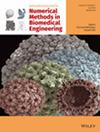A Novel Finite Element Analysis Aided Multiobjective Shape Optimization Approach for Cementless Femoral Components in Hip Implants
Abstract
The purpose of this study was to propose a multiobjective shape optimization approach using the MOPSO algorithm for the femoral stems with the aim of increasing the long-term survivorship of hip implants. The Taperloc Complete femoral stem was selected and its reference geometry was defined with 67 variables. 10 new stem shapes were produced as the swarm members by randomly changing the values of the variables. The values of the stress shielding, initial relative micro-motion, and bone-implant interface stress for each stem shape were calculated as the objectives by the finite element analysis and the position of each swarm member was updated iteratively. The geometry that caused a 37% and 45% decrease in the interface stress and stress shielding, respectively, and a 65% increase in the initial micro-motion compared to the Taperloc Complete stem was selected as the optimized shape. It was shown that thinning the femoral stems without changing their length reduced the induced stress shielding and initial micro-motion and increased the interface stress, whereas shortening the femoral stems reduced the stress shielding and interface stress and increased the initial micro-motion. The proposed approach may be used for the shape optimization of commercial femoral stems to increase their lifetime.


 求助内容:
求助内容: 应助结果提醒方式:
应助结果提醒方式:


